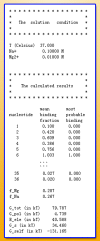TBI server: a web server for predicting ion effects in RNA folding
- PMID: 25798933
- PMCID: PMC4370743
- DOI: 10.1371/journal.pone.0119705
TBI server: a web server for predicting ion effects in RNA folding
Abstract
Background: Metal ions play a critical role in the stabilization of RNA structures. Therefore, accurate prediction of the ion effects in RNA folding can have a far-reaching impact on our understanding of RNA structure and function. Multivalent ions, especially Mg²⁺, are essential for RNA tertiary structure formation. These ions can possibly become strongly correlated in the close vicinity of RNA surface. Most of the currently available software packages, which have widespread success in predicting ion effects in biomolecular systems, however, do not explicitly account for the ion correlation effect. Therefore, it is important to develop a software package/web server for the prediction of ion electrostatics in RNA folding by including ion correlation effects.
Results: The TBI web server http://rna.physics.missouri.edu/tbi_index.html provides predictions for the total electrostatic free energy, the different free energy components, and the mean number and the most probable distributions of the bound ions. A novel feature of the TBI server is its ability to account for ion correlation and ion distribution fluctuation effects.
Conclusions: By accounting for the ion correlation and fluctuation effects, the TBI server is a unique online tool for computing ion-mediated electrostatic properties for given RNA structures. The results can provide important data for in-depth analysis for ion effects in RNA folding including the ion-dependence of folding stability, ion uptake in the folding process, and the interplay between the different energetic components.
Conflict of interest statement
Figures







Similar articles
-
MCTBI: a web server for predicting metal ion effects in RNA structures.RNA. 2017 Aug;23(8):1155-1165. doi: 10.1261/rna.060947.117. Epub 2017 Apr 27. RNA. 2017. PMID: 28450533 Free PMC article.
-
Vfold: a web server for RNA structure and folding thermodynamics prediction.PLoS One. 2014 Sep 12;9(9):e107504. doi: 10.1371/journal.pone.0107504. eCollection 2014. PLoS One. 2014. PMID: 25215508 Free PMC article.
-
Predicting electrostatic forces in RNA folding.Methods Enzymol. 2009;469:465-87. doi: 10.1016/S0076-6879(09)69022-4. Epub 2009 Nov 17. Methods Enzymol. 2009. PMID: 20946803 Free PMC article.
-
Importance of diffuse metal ion binding to RNA.Met Ions Life Sci. 2011;9:101-24. Met Ions Life Sci. 2011. PMID: 22010269 Free PMC article. Review.
-
Energy-based RNA consensus secondary structure prediction in multiple sequence alignments.Methods Mol Biol. 2014;1097:125-41. doi: 10.1007/978-1-62703-709-9_7. Methods Mol Biol. 2014. PMID: 24639158 Review.
Cited by
-
Predicting Monovalent Ion Correlation Effects in Nucleic Acids.ACS Omega. 2019 Aug 5;4(8):13435-13446. doi: 10.1021/acsomega.9b01689. eCollection 2019 Aug 20. ACS Omega. 2019. PMID: 31460472 Free PMC article.
-
Predicting Molecular Crowding Effects in Ion-RNA Interactions.J Phys Chem B. 2016 Sep 1;120(34):8837-44. doi: 10.1021/acs.jpcb.6b05625. Epub 2016 Aug 12. J Phys Chem B. 2016. PMID: 27490487 Free PMC article.
-
RNA-ligand molecular docking: advances and challenges.Wiley Interdiscip Rev Comput Mol Sci. 2022 May-Jun;12(3):e1571. doi: 10.1002/wcms.1571. Epub 2021 Aug 16. Wiley Interdiscip Rev Comput Mol Sci. 2022. PMID: 37293430 Free PMC article.
-
Thermostability, Tunability, and Tenacity of RNA as Rubbery Anionic Polymeric Materials in Nanotechnology and Nanomedicine-Specific Cancer Targeting with Undetectable Toxicity.Chem Rev. 2021 Jul 14;121(13):7398-7467. doi: 10.1021/acs.chemrev.1c00009. Epub 2021 May 26. Chem Rev. 2021. PMID: 34038115 Free PMC article. Review.
References
-
- Bowman JC, Lenz TK, Hud NV, Williams LD. Cations in charge: magnesium ions in RNA folding and catalysis. Curr Opin Chem Biol. 2012;22: 262–272. - PubMed
-
- Ha BY, Thirumalai D. Bending rigidity of stiff polyelectrolyte chains: A single chain and a bundle of multichains. Macromolecules. 2003;36: 9658–9666. 10.1021/ma021226k - DOI
Publication types
MeSH terms
Substances
Grants and funding
LinkOut - more resources
Full Text Sources
Other Literature Sources

